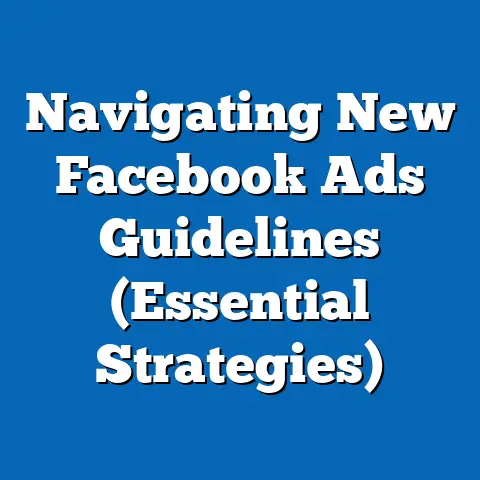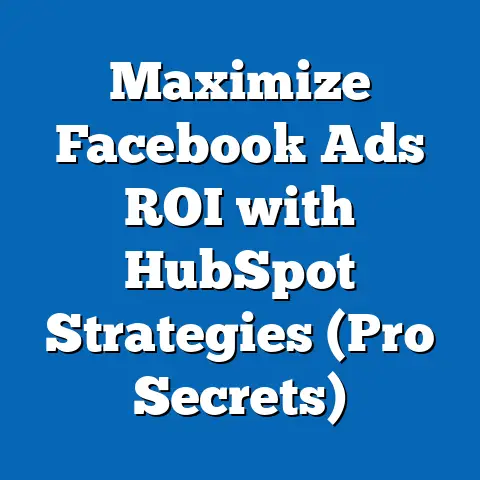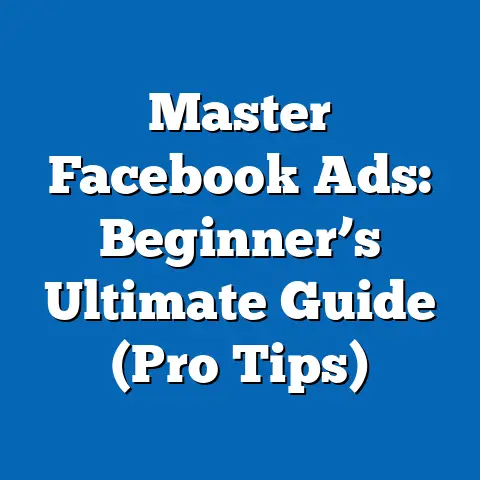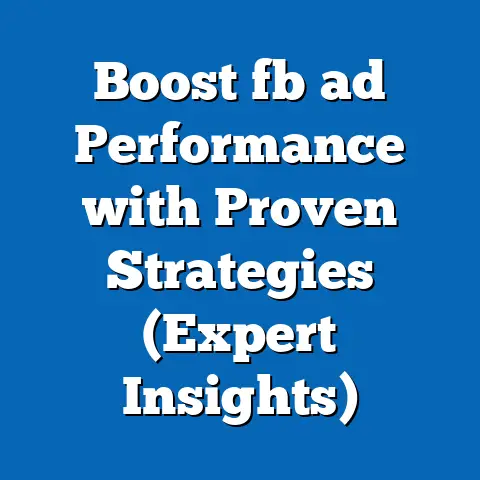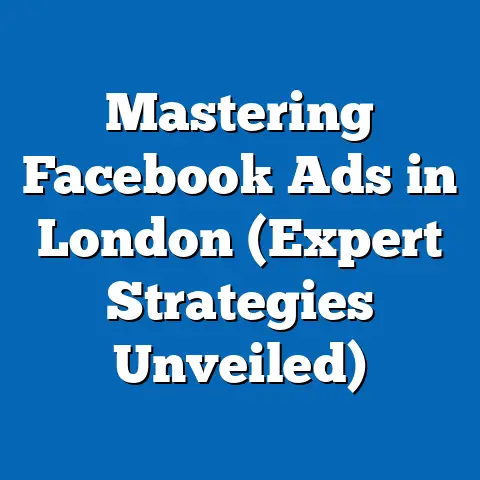Maximize HubSpot Facebook Ads Success (Proven Strategies)
In today’s world, where consumers are increasingly conscious of the impact their choices have on the planet, sustainability isn’t just a buzzword; it’s a core value. Businesses are recognizing this shift, and are actively seeking ways to incorporate sustainable practices into their operations, including their marketing strategies. This means creating advertising campaigns that not only drive results but also resonate with the values of socially-conscious consumers. We’re talking about a move towards sustainable advertising strategies – ones that are effective, ethical, and environmentally responsible.
Digital advertising, particularly on platforms like Facebook, offers an incredible opportunity to communicate these values. With its vast reach and sophisticated targeting capabilities, Facebook allows brands to connect with audiences who share their commitment to sustainability. But simply running ads isn’t enough. To truly maximize success, you need a powerful tool that can help you manage, analyze, and optimize your campaigns. That’s where HubSpot comes in.
HubSpot, a comprehensive marketing platform, offers seamless integration with Facebook Ads, allowing you to leverage its analytics and CRM capabilities to create highly effective and sustainable advertising campaigns. In this article, I’ll be sharing proven strategies for maximizing your success with HubSpot Facebook Ads, helping you achieve your business goals while staying true to your values. I’ve seen firsthand how these strategies can transform a campaign from mediocre to outstanding, and I’m excited to share my insights with you.
Understanding HubSpot and Facebook Ads
Let’s start with a quick overview of each platform.
HubSpot: Think of HubSpot as your central hub for all things marketing, sales, and customer service. It’s a powerful platform that helps you attract visitors, convert leads, and close customers. Key features include:
- CRM (Customer Relationship Management): This is the heart of HubSpot, allowing you to track and manage your interactions with customers and prospects.
- Marketing Automation: Automate repetitive tasks like email marketing, social media posting, and lead nurturing.
- Analytics: Track your website traffic, lead generation, and campaign performance.
- Content Management System (CMS): Build and manage your website and blog.
Facebook Ads: With its massive user base (over 2.9 billion monthly active users as of 2024), Facebook offers unparalleled reach for advertisers. Its sophisticated targeting options allow you to reach specific demographics, interests, and behaviors. Key features include:
- Audience Targeting: Target your ideal customers based on demographics, interests, behaviors, and more.
- Ad Formats: Choose from a variety of ad formats, including images, videos, carousels, and lead ads.
- Campaign Objectives: Optimize your campaigns for specific goals, such as brand awareness, lead generation, or sales conversions.
- Ad Manager: A powerful tool for creating, managing, and analyzing your Facebook ad campaigns.
The Synergy: The real magic happens when you combine the power of HubSpot and Facebook Ads. By integrating the two platforms, you can:
- Leverage HubSpot’s CRM data for better targeting: Use your customer data in HubSpot to create highly targeted Facebook ad campaigns.
- Track Facebook ad performance in HubSpot: See how your Facebook ads are contributing to your overall marketing goals.
- Automate lead nurturing: Automatically enroll leads generated from Facebook ads into HubSpot workflows.
- Personalize ad experiences: Use HubSpot data to personalize your Facebook ad creatives.
I remember working with a client who was struggling to generate leads through Facebook ads. They were running broad targeting campaigns and weren’t seeing the results they wanted. By integrating HubSpot with their Facebook Ads account, we were able to leverage their existing customer data to create highly targeted lookalike audiences. The result? A 300% increase in lead generation within the first month!
Takeaway: Understanding the individual strengths of HubSpot and Facebook Ads, and how they work together, is the foundation for maximizing your advertising success.
Setting Clear Objectives for Your Ads
Before you even think about creating your first Facebook ad, it’s crucial to define your objectives. What do you want to achieve with your campaign? Are you looking to increase brand awareness, generate leads, drive sales, or something else entirely?
Having clear and measurable objectives is essential for several reasons:
- It provides direction: Clear objectives give your campaign a purpose and help you stay focused.
- It allows you to measure success: Without clear objectives, it’s impossible to determine whether your campaign is successful.
- It informs your strategy: Your objectives will influence your targeting, ad creatives, and bidding strategy.
HubSpot’s tools can help you set and track these objectives effectively. Within HubSpot, you can define specific goals for your marketing campaigns, track your progress towards those goals, and analyze your results.
SMART Goals: A helpful framework for setting objectives is the SMART acronym:
- Specific: Your objective should be clear and well-defined.
- Measurable: You should be able to track your progress towards your objective.
- Achievable: Your objective should be realistic and attainable.
- Relevant: Your objective should align with your overall business goals.
- Time-bound: You should set a deadline for achieving your objective.
Examples of SMART Goals for Facebook Ads:
- Increase brand awareness by 20% within the next quarter. (Tracked by monitoring website traffic and social media engagement.)
- Generate 100 qualified leads within the next month. (Tracked by monitoring lead form submissions and lead scoring in HubSpot.)
- Drive $5,000 in sales within the next two months. (Tracked by monitoring e-commerce transactions and attributing sales to Facebook ads.)
When I started my first Facebook Ad campaign, I made the mistake of not setting clear objectives. I simply wanted to “get more traffic” to my website. As you can imagine, the results were underwhelming. I was getting clicks, but they weren’t converting into anything meaningful. It wasn’t until I sat down and defined specific, measurable objectives that I started to see real results.
Takeaway: Defining clear, measurable, and time-bound objectives is the first step towards achieving success with HubSpot Facebook Ads. Use the SMART framework to guide your goal-setting process.
Targeting the Right Audience
One of the biggest advantages of Facebook advertising is its sophisticated targeting options. You can target your ideal customers based on a wide range of factors, including:
- Demographics: Age, gender, location, education, job title, etc.
- Interests: Hobbies, interests, pages they like, etc.
- Behaviors: Purchase history, website activity, mobile device usage, etc.
- Lookalike Audiences: Reach new people who are similar to your existing customers.
- Custom Audiences: Target your existing customers and prospects based on their email addresses, phone numbers, or website activity.
HubSpot’s CRM data can provide invaluable insights into your customer personas and help you refine your audience targeting on Facebook. By analyzing your customer data, you can identify common characteristics, interests, and behaviors that you can use to create highly targeted ad campaigns.
Actionable Strategies for Leveraging HubSpot Data:
- Create Customer Personas: Develop detailed profiles of your ideal customers based on your HubSpot data. Include information such as demographics, interests, pain points, and goals.
- Segment Your Audience: Divide your audience into smaller, more targeted segments based on their characteristics and behaviors.
- Create Custom Audiences: Upload your customer email list to Facebook to create a custom audience of your existing customers.
- Create Lookalike Audiences: Use your custom audience to create a lookalike audience of new people who are similar to your existing customers.
- Target Website Visitors: Use the Facebook Pixel to track website visitors and target them with relevant ads.
For example, let’s say you’re selling sustainable clothing. You can use HubSpot to identify your most loyal customers and analyze their interests and behaviors. You might find that they are interested in environmentalism, ethical fashion, and outdoor activities. You can then use this information to create a Facebook ad campaign targeting people who share these interests.
I once worked with a non-profit organization that was struggling to reach new donors. By analyzing their donor data in HubSpot, we discovered that their most loyal donors were primarily women aged 45-65 who were interested in education and community development. We then created a Facebook ad campaign targeting this specific demographic, and the results were remarkable. We saw a significant increase in donations and a much higher return on ad spend.
Takeaway: Effective audience targeting is crucial for maximizing the ROI of your Facebook ad campaigns. Leverage HubSpot’s CRM data to gain insights into your customer personas and create highly targeted ad campaigns.
Crafting Compelling Ad Content
Even with perfect targeting, your ads won’t be successful if your content isn’t compelling. Your ad content should be eye-catching, persuasive, and relevant to your target audience.
Here are the key elements of successful Facebook ad content:
- Eye-catching Visuals: Use high-quality images or videos that grab attention and convey your message effectively.
- Persuasive Copy: Write clear, concise, and engaging copy that highlights the benefits of your product or service.
- Strong Call-to-Action: Tell people exactly what you want them to do, such as “Learn More,” “Shop Now,” or “Sign Up.”
- Relevance: Make sure your ad content is relevant to your target audience and their interests.
HubSpot offers tools for creating and A/B testing ad creatives to find the most effective combinations. You can use HubSpot’s design tools to create visually appealing ad creatives, and you can use HubSpot’s A/B testing features to test different ad copy, images, and calls-to-action.
Best Practices for Aligning Ad Content with Sustainability Messaging:
- Highlight Sustainable Practices: Showcase your company’s commitment to sustainability, such as using eco-friendly materials, reducing waste, or supporting environmental initiatives.
- Focus on Benefits: Emphasize the benefits of your sustainable products or services, such as improved health, reduced environmental impact, or ethical sourcing.
- Use Authentic Language: Avoid greenwashing and use authentic language that resonates with socially-conscious consumers.
- Tell Your Story: Share your company’s sustainability journey and the values that drive your commitment to responsible practices.
- Showcase Certifications: If your products or services are certified by reputable organizations (e.g., Fair Trade, Organic, LEED), highlight these certifications in your ads.
I’ve seen many companies try to jump on the sustainability bandwagon without truly committing to it. This often results in “greenwashing,” which can damage your brand reputation and alienate your target audience. It’s important to be authentic and transparent in your sustainability messaging.
Takeaway: Crafting compelling ad content is essential for capturing the attention of your target audience and driving conversions. Align your ad content with sustainability messaging to resonate with socially-conscious consumers.
Budgeting and Bidding Strategies
Setting an effective budget and bidding strategy is crucial for maximizing the efficiency of your Facebook ad spend. Facebook offers several budgeting options, including:
- Daily Budget: The average amount you’re willing to spend each day.
- Lifetime Budget: The total amount you’re willing to spend over the lifetime of your campaign.
When setting your budget, consider your overall marketing goals, your target audience, and the cost of reaching that audience. HubSpot’s insights can help you inform your budget allocation by providing data on your customer acquisition cost (CAC) and lifetime value (LTV).
Bidding Strategies: Facebook offers several bidding strategies, including:
- Lowest Cost: Facebook will try to get you the most results for your budget.
- Cost Cap: You set a target cost per result, and Facebook will try to stay within that cost.
- Bid Cap: You set a maximum bid amount, and Facebook will never bid higher than that amount.
- Value Optimization: (For e-commerce) Facebook will try to find people who are likely to make high-value purchases.
The best bidding strategy for you will depend on your campaign objectives and your budget. If you’re just starting out, the “Lowest Cost” strategy is a good option. As you gain more data, you can experiment with other bidding strategies to see which one performs best for you.
Tips for Monitoring and Adjusting Budgets:
- Track Your Performance: Regularly monitor your campaign performance metrics, such as cost per click (CPC), cost per acquisition (CPA), and return on ad spend (ROAS).
- Adjust Your Budget: If you’re seeing good results, consider increasing your budget to reach more people. If you’re not seeing the results you want, consider decreasing your budget or adjusting your targeting and ad creatives.
- Use Automated Rules: Set up automated rules in Facebook Ads Manager to automatically adjust your budget based on performance metrics.
I once worked with a client who was overspending on their Facebook ad campaigns without seeing a positive return. By analyzing their campaign data and adjusting their bidding strategy, we were able to significantly reduce their ad spend while still generating the same number of leads.
Takeaway: Setting an effective budget and bidding strategy is crucial for maximizing the ROI of your Facebook ad spend. Use HubSpot’s insights to inform your budget allocation and monitor your campaign performance regularly.
Measuring and Analyzing Performance
Regularly measuring and analyzing your Facebook ad performance is essential for refining your strategies and maximizing your results. This is where HubSpot’s analytics tools truly shine.
Key Performance Indicators (KPIs) to Focus On:
- Click-Through Rate (CTR): The percentage of people who see your ad and click on it. A high CTR indicates that your ad is relevant and engaging.
- Conversion Rate: The percentage of people who click on your ad and complete a desired action, such as filling out a form or making a purchase.
- Cost Per Click (CPC): The amount you pay each time someone clicks on your ad.
- Cost Per Acquisition (CPA): The amount you pay for each conversion.
- Return on Ad Spend (ROAS): The amount of revenue you generate for every dollar you spend on advertising.
HubSpot’s analytics tools can help you track these metrics and make data-driven decisions for continuous improvement. You can track your Facebook ad performance directly within HubSpot, allowing you to see how your ads are contributing to your overall marketing goals.
How to Use HubSpot Analytics for Facebook Ads:
- Connect Your Facebook Ads Account to HubSpot: This will allow HubSpot to automatically track your Facebook ad performance data.
- Create Custom Reports: Create custom reports in HubSpot to track the KPIs that are most important to you.
- Analyze Your Data: Analyze your data to identify trends and patterns. What ads are performing well? What audiences are responding best to your ads?
- Make Adjustments: Based on your analysis, make adjustments to your targeting, ad creatives, and bidding strategy.
I recommend setting up a regular reporting schedule (e.g., weekly or monthly) to review your Facebook ad performance and identify areas for improvement.
Takeaway: Regularly measuring and analyzing your Facebook ad performance is essential for refining your strategies and maximizing your results. Leverage HubSpot’s analytics tools to track your KPIs and make data-driven decisions.
Scaling Successful Campaigns
Once you’ve identified successful Facebook ad campaigns, the next step is to scale them. Scaling your campaigns involves increasing your budget, expanding your targeting, and testing new ad creatives to reach a wider audience.
Strategies for Scaling Successful Campaigns:
- Increase Your Budget: Gradually increase your budget while monitoring your performance metrics.
- Expand Your Targeting: Test new targeting options to reach a wider audience.
- Create New Ad Creatives: Develop new ad creatives to keep your audience engaged.
- Use Lookalike Audiences: Create lookalike audiences to reach new people who are similar to your existing customers.
- Test New Ad Placements: Experiment with different ad placements, such as Facebook News Feed, Instagram Feed, and Audience Network.
It’s important to scale your campaigns gradually and monitor your performance metrics closely. Avoid making drastic changes to your campaigns, as this can disrupt your performance.
The Importance of Iterative Testing and Refinement:
Scaling isn’t just about spending more money; it’s about continuing to optimize your campaigns for maximum effectiveness. This requires iterative testing and refinement. Continuously test new ad creatives, targeting options, and bidding strategies to identify what works best for your audience.
Examples of Successful Campaign Scaling:
Conclusion
In conclusion, maximizing success with HubSpot Facebook Ads requires a strategic approach that combines the power of both platforms. By setting clear objectives, targeting the right audience, crafting compelling ad content, setting an effective budget, measuring and analyzing performance, and scaling successful campaigns, you can achieve significant results and drive sustainable growth for your business.
Remember, the key is to be authentic, transparent, and committed to your sustainability values. By aligning your Facebook ad campaigns with your company’s mission and values, you can resonate with socially-conscious consumers and build a loyal customer base.
Now, I encourage you to take action! Embrace these proven strategies, leverage the power of HubSpot, and achieve sustainable growth through Facebook advertising. The world needs more companies that are committed to making a positive impact, and I believe that you can be one of them. So, go out there and create some amazing, sustainable, and successful Facebook ad campaigns!

